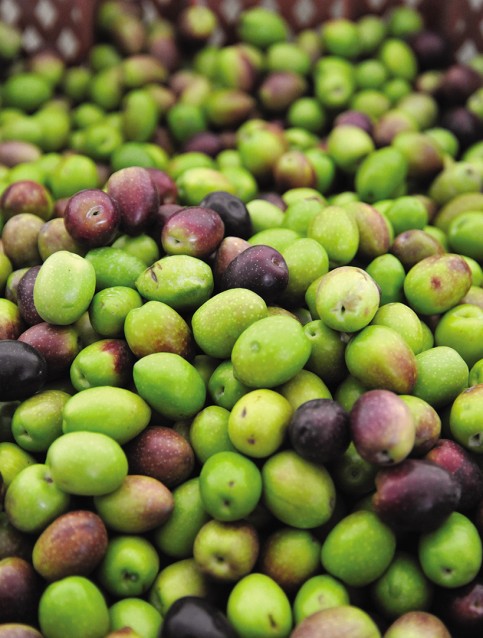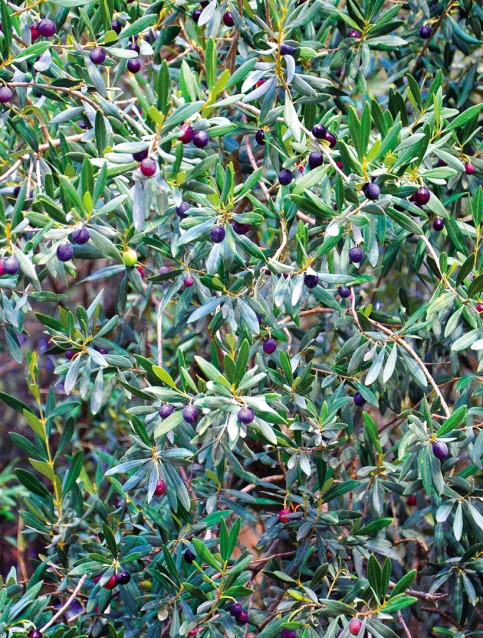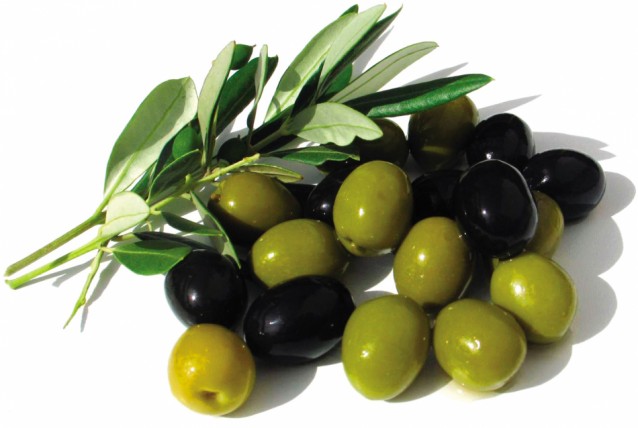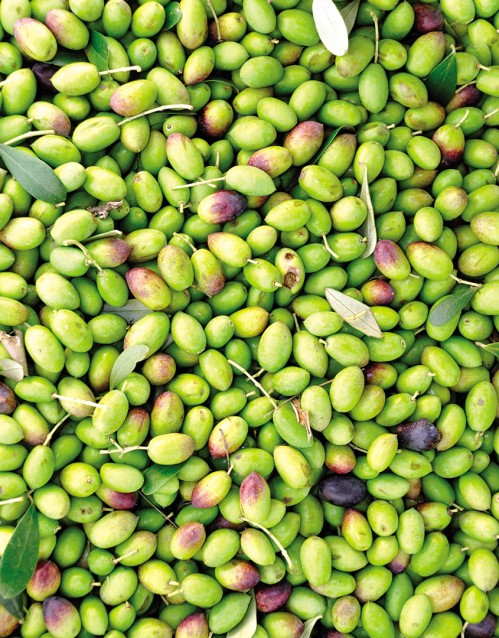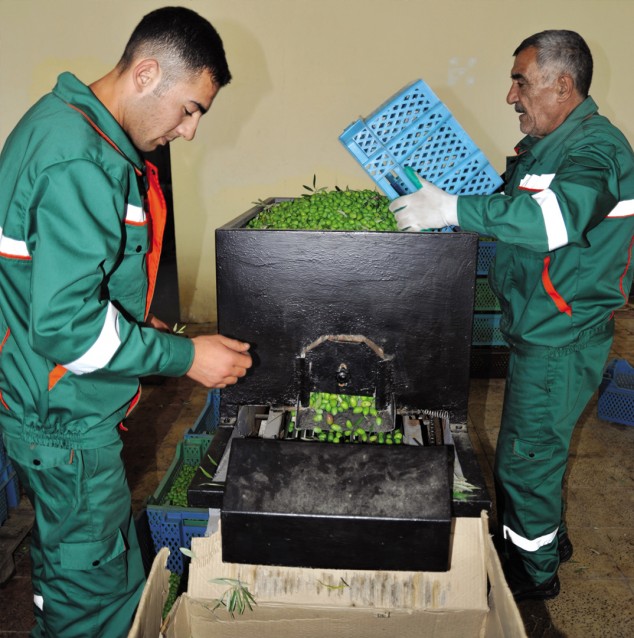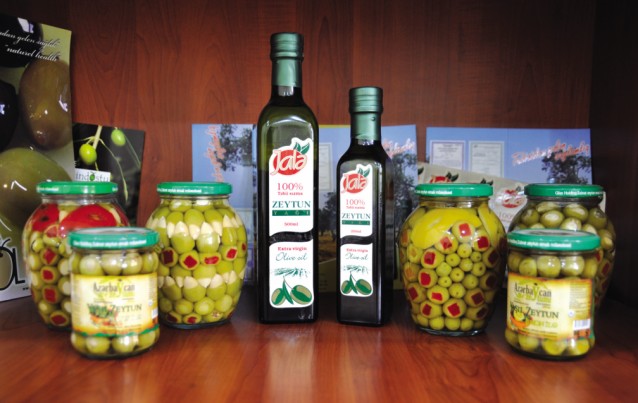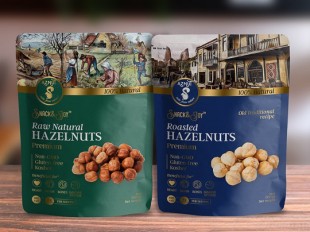Symbol of longevity and peace
The cultivation of olive trees can safely be recorded as one of the earliest achievements of human civilization. Archaeological data indicates that the first olive was growing thirty millennia BC. Legend credits the goddess Athena with its creation as she competed with Poseidon, the god of the sea and storms, for the right to be patron deity of Athens. The sea-god struck his trident into a rock - and a salt water spring began to flow. Athena plunged a spear into the ground and presented the Athenians with the olive tree that grew there.Surrounded by these legends, olives have always been seen as a symbol of longevity and peace. Their creation was enough for Athena to win the hearts of the Greeks. In Greek mythology the olive tree also symbolizes wisdom, prosperity and fertility. Its branches were woven into a wreath for winners at the Olympic Games and were also part of wedding ceremonies. Religions have their olive stories too, in which the tree is a symbol of peace between God and man. Thus a dove signalled the end of the Flood by returning to Noah with an olive branch in its beak. It is still the custom in some Mediterranean countries for a man to plant an olive tree before marrying.
Liquid gold
Wise men used to marvel at the extraordinary stability of the tree and believed that the olive did not die. It does indeed grow very slowly and can live for up to 2,500 years. Those who consume olives may share some of its endurance and vitality. People of the Mediterranean, the ancestors of present-day Greeks, Spaniards and Italians, began cultivating olives in the fifth millennium BC.The fruit is rich in sugar, protein, pectin, vitamins B and C and carotene. The riper the fruit, the more oil it contains (in the fully ripe fruit used to produce oil - up to 75 percent).
The best part of the olive is its oil. In its long history olive oil has played many roles, from money to drugs, and is inseparable from Mediterranean culture.
Two liquids are very useful for the human body - wrote the Roman philosopher Pliny – They are wine, which is consumed orally, and olive oil, which is smeared on the body. You can do without wine sooner than without oil.
So, olive oil is deservedly labelled liquid gold.
It has for centuries been praised for its culinary and health-giving qualities. In ancient Rome, the golden oil was so popular that had its own special ships to transport it to trading places in different parts of the world.
Zeytun orchards
Five elements are generally considered necessary for the successful cultivation of olive trees, there should be sun, stones, dry atmosphere, quiet and privacy. All can be found in abundance in the sunny Mediterranean as well as in Azerbaijan Here olives are called zeytun and most zeytun trees are to be found growing on the Absheron Peninsula, which has the most suitable soil. The olive is not so demanding of the soil, but it does like sun and water. So the more water goes to the tree, the greater the promise of oil.Local experts believe that the country can develop the culture and profit further from the fruit. In the best case, just one hectare of olive grove can yield 2-2.5 tons of fruit. Thus successful olive production (for canned olives, olive oil) can bring in colossal revenues.
While up to 30 kilograms can be collected from a single tree, the collecting process is not so easy and requires great skill. Following the experience of the ancient Greeks, olive picking should be done only by hand; the fruit can be ruined by mechanical picking. Another point here is that olives for eating should be collected only when green. Olives on Azerbaijani trees that go dark purple or black are used to produce oil. Only the green olives are eaten. But not in their raw form; they should be processed. There are different methods of preserving olives, but the principle is the same: first the bitterness is removed by leaving them in a weak alkali solution for a few hours, then washing with brine and packing into cans. Canned olives are easily digested. Doctors say that a regular intake of black and green olives offers protection against gastrointestinal and cardiovascular illnesses.
Olives have been cultivated in Azerbaijan for a very long time. They can be found at almost at every turn in Baku; they were planted in the capital´s parks, school yards, and even at roadsides. They are unpretentious and evergreen and local people like to gather the fruit. Whole families walking through the streets and parks to pick olives for the winter was once a common sight.
In search of a local brand
It is different now. Whether people have grown lazy, or it is just easier to buy canned olives from the shops, it is rare now to see people collecting olives from trees on the streets. There are plenty in the stores, including local brands among the imports. One such belongs to Gilan Holding. We were interested in the process of olive harvesting so Visions of Azerbaijan visited one of the company’s olive products plant. Pasha Guliyev, the young, enterprising director of Gilan Zeytun, made us very welcome and gave us a detailed tour of the harvesting process.It turned out that the plant has been in operation since Soviet times. With the collapse of the USSR it continued, but struggled to make a reasonable profit. Gilan Zeytun took over in 2008, breathed new life into the enterprise and began to produce olives under its brand. As Mr Guliyev told us, they have a variety of products, but mainly produce Jalə olive oil and Azərbaycan Zeytunu canned olives.
Our olive oil is produced by a first cold pressing, and are known as extra virgin; we use the most up-to-date equipment brought in specially from Italy. We comply with international standards in ensuring that there are no minerals or heavy metals in the oil, but we retain the vitamins specific to olives, so it is a health-supporting product. The oil reduces levels of cholesterol in the blood, helps to eliminate toxins and improves blood circulation.
Unlike other plants, Gilan Zeytun does not produce refined oil. Mr Guliyev told us that the refining process usually eliminates the aroma and the vitamins; it also lowers the quality of the oil. The plant takes in more than 300 tons of olives annually from Zeytun Baglari on the Absheron Peninsula. About 100 tons are canned and the rest are used to produce oil, usually extracted from ripe black zeytun olives which are 15-16 per cent oil. Green olives contain no more than 10 per cent. Thus the green olives are canned and the black ones are pressed for oil.
The special pleasure of zeytun
Azerbaijani canned olives are different from those olives grown in let’s say Turkey or Greece. The main difference is in flavour. As they say, each to his own taste. Obviously I prefer the delicious Azerbaijani zeytun. As we discovered, the difference lies in the recipe. Senior technologist Elkhan Huseynov enlightened us:Vinegar is often added to canned olives but we don’t use vinegar at all, instead we add natural salt from Nakhchivan (Azerbaijan). The Azerbaijani zeytun special has the best attributes of olives. You know, there are more than 600 kinds of olive in the world; some contain more oil, some less. The Azerbaijani type is not regarded as very oily, but it has other qualities; it is very healthy and good for the diet. Look, Baku’s weather sometimes springs surprises; it can be very windy or arid. Olive trees are actually hygrophilous, but zeytun have become used to our changeable climate. No other kinds of olive can grow in Absheron as successfully as zeytun. And that is its special pleasure for us.
Mr Huseynov told us that the plant which now belongs to Gilan Holding was previously the only olive production plant in the post-Soviet area. In the 1980s the plant supplied oil and canned olives not only to the Soviet republics but also to Libya and Czechoslovakia.
I remember that the plant was most profitable in the mid 1980s. I was working here then. Imagine, the plant used nearly 2,500 tons of olives annually… Now we are submitting our products to international markets. Here in Azerbaijan there are limited numbers of olive production plants, so it’s easy for us to compete with local producers. But we cannot compete yet with foreign brands. It takes time and persistence.
Nowadays, the area covered by olive groves is smaller than in Soviet times. Olive production is also greatly reduced. There is now only one state plant, in Hovsan, Absheron. But Mr Huseynov said that the government has been trying to rebuild in recent years. Today, Azerbaijan still imports canned olives and olive oil and there is a small space for local products, which are currently all sold on the domestic market. Foreign products still dominate, but this is not surprising since we live now in a market economy, in which every consumer should have the right to choose.
Jam from green olives?
In the final stage of our trip to Gilan Zeytun we were surprised to come across bottles of jam made from…well, from green olives. They looked so appetizing. Stuffed with walnuts, they were a very exotic taste. Olives, then, are something quite different. But in whatever form you take them, they are always healthy and useful. Eat olives and live long!People have enjoyed them for thousands of years. Traders have transported them around the world since the earliest of times, convincing people of their flavour and versatility. The oil produced from the fruit is much appreciated for its many useful properties, especially its beneficial impact on health and beauty. They have an ancient history, even featuring in Greek legends and mythology. They are found mostly in Mediterranean countries, but also in Azerbaijan. Let us take you a little further into the story of the olive.
Symbol of longevity and peace
The cultivation of olive trees can safely be recorded as one of the earliest achievements of human civilization. Archaeological data indicates that the first olive was growing thirty millennia BC. Legend credits the goddess Athena with its creation as she competed with Poseidon, the god of the sea and storms, for the right to be patron deity of Athens. The sea-god struck his trident into a rock - and a salt water spring began to flow. Athena plunged a spear into the ground and presented the Athenians with the olive tree that grew there.Surrounded by these legends, olives have always been seen as a symbol of longevity and peace. Their creation was enough for Athena to win the hearts of the Greeks. In Greek mythology the olive tree also symbolizes wisdom, prosperity and fertility. Its branches were woven into a wreath for winners at the Olympic Games and were also part of wedding ceremonies. Religions have their olive stories too, in which the tree is a symbol of peace between God and man. Thus a dove signalled the end of the Flood by returning to Noah with an olive branch in its beak. It is still the custom in some Mediterranean countries for a man to plant an olive tree before marrying.
Liquid gold
Wise men used to marvel at the extraordinary stability of the tree and believed that the olive did not die. It does indeed grow very slowly and can live for up to 2,500 years. Those who consume olives may share some of its endurance and vitality. People of the Mediterranean, the ancestors of present-day Greeks, Spaniards and Italians, began cultivating olives in the fifth millennium BC.The fruit is rich in sugar, protein, pectin, vitamins B and C and carotene. The riper the fruit, the more oil it contains (in the fully ripe fruit used to produce oil - up to 75 percent).
The best part of the olive is its oil. In its long history olive oil has played many roles, from money to drugs, and is inseparable from Mediterranean culture.
Two liquids are very useful for the human body - wrote the Roman philosopher Pliny – They are wine, which is consumed orally, and olive oil, which is smeared on the body. You can do without wine sooner than without oil.
So, olive oil is deservedly labelled liquid gold.
It has for centuries been praised for its culinary and health-giving qualities. In ancient Rome, the golden oil was so popular that had its own special ships to transport it to trading places in different parts of the world.
Zeytun orchards
Five elements are generally considered necessary for the successful cultivation of olive trees, there should be sun, stones, dry atmosphere, quiet and privacy. All can be found in abundance in the sunny Mediterranean as well as in Azerbaijan Here olives are called zeytun and most zeytun trees are to be found growing on the Absheron Peninsula, which has the most suitable soil. The olive is not so demanding of the soil, but it does like sun and water. So the more water goes to the tree, the greater the promise of oil.Local experts believe that the country can develop the culture and profit further from the fruit. In the best case, just one hectare of olive grove can yield 2-2.5 tons of fruit. Thus successful olive production (for canned olives, olive oil) can bring in colossal revenues.
While up to 30 kilograms can be collected from a single tree, the collecting process is not so easy and requires great skill. Following the experience of the ancient Greeks, olive picking should be done only by hand; the fruit can be ruined by mechanical picking. Another point here is that olives for eating should be collected only when green. Olives on Azerbaijani trees that go dark purple or black are used to produce oil. Only the green olives are eaten. But not in their raw form; they should be processed. There are different methods of preserving olives, but the principle is the same: first the bitterness is removed by leaving them in a weak alkali solution for a few hours, then washing with brine and packing into cans. Canned olives are easily digested. Doctors say that a regular intake of black and green olives offers protection against gastrointestinal and cardiovascular illnesses.
Olives have been cultivated in Azerbaijan for a very long time. They can be found at almost at every turn in Baku; they were planted in the capital´s parks, school yards, and even at roadsides. They are unpretentious and evergreen and local people like to gather the fruit. Whole families walking through the streets and parks to pick olives for the winter was once a common sight.
In search of a local brand
It is different now. Whether people have grown lazy, or it is just easier to buy canned olives from the shops, it is rare now to see people collecting olives from trees on the streets. There are plenty in the stores, including local brands among the imports. One such belongs to Gilan Holding. We were interested in the process of olive harvesting so Visions of Azerbaijan visited one of the company’s olive products plant. Pasha Guliyev, the young, enterprising director of Gilan Zeytun, made us very welcome and gave us a detailed tour of the harvesting process.It turned out that the plant has been in operation since Soviet times. With the collapse of the USSR it continued, but struggled to make a reasonable profit. Gilan Zeytun took over in 2008, breathed new life into the enterprise and began to produce olives under its brand. As Mr Guliyev told us, they have a variety of products, but mainly produce Jalə olive oil and Azərbaycan Zeytunu canned olives.
Our olive oil is produced by a first cold pressing, and are known as extra virgin; we use the most up-to-date equipment brought in specially from Italy. We comply with international standards in ensuring that there are no minerals or heavy metals in the oil, but we retain the vitamins specific to olives, so it is a health-supporting product. The oil reduces levels of cholesterol in the blood, helps to eliminate toxins and improves blood circulation.
Unlike other plants, Gilan Zeytun does not produce refined oil. Mr Guliyev told us that the refining process usually eliminates the aroma and the vitamins; it also lowers the quality of the oil. The plant takes in more than 300 tons of olives annually from Zeytun Baglari on the Absheron Peninsula. About 100 tons are canned and the rest are used to produce oil, usually extracted from ripe black zeytun olives which are 15-16 per cent oil. Green olives contain no more than 10 per cent. Thus the green olives are canned and the black ones are pressed for oil.
The special pleasure of zeytun
Azerbaijani canned olives are different from those olives grown in let’s say Turkey or Greece. The main difference is in flavour. As they say, each to his own taste. Obviously I prefer the delicious Azerbaijani zeytun. As we discovered, the difference lies in the recipe. Senior technologist Elkhan Huseynov enlightened us:Vinegar is often added to canned olives but we don’t use vinegar at all, instead we add natural salt from Nakhchivan (Azerbaijan). The Azerbaijani zeytun special has the best attributes of olives. You know, there are more than 600 kinds of olive in the world; some contain more oil, some less. The Azerbaijani type is not regarded as very oily, but it has other qualities; it is very healthy and good for the diet. Look, Baku’s weather sometimes springs surprises; it can be very windy or arid. Olive trees are actually hygrophilous, but zeytun have become used to our changeable climate. No other kinds of olive can grow in Absheron as successfully as zeytun. And that is its special pleasure for us.
Mr Huseynov told us that the plant which now belongs to Gilan Holding was previously the only olive production plant in the post-Soviet area. In the 1980s the plant supplied oil and canned olives not only to the Soviet republics but also to Libya and Czechoslovakia.
I remember that the plant was most profitable in the mid 1980s. I was working here then. Imagine, the plant used nearly 2,500 tons of olives annually… Now we are submitting our products to international markets. Here in Azerbaijan there are limited numbers of olive production plants, so it’s easy for us to compete with local producers. But we cannot compete yet with foreign brands. It takes time and persistence.
Nowadays, the area covered by olive groves is smaller than in Soviet times. Olive production is also greatly reduced. There is now only one state plant, in Hovsan, Absheron. But Mr Huseynov said that the government has been trying to rebuild in recent years. Today, Azerbaijan still imports canned olives and olive oil and there is a small space for local products, which are currently all sold on the domestic market. Foreign products still dominate, but this is not surprising since we live now in a market economy, in which every consumer should have the right to choose.
